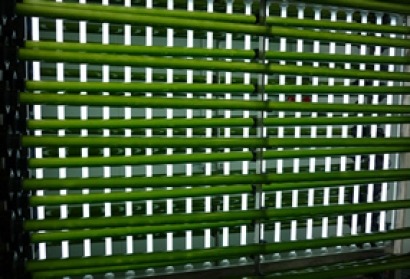
The main objective is to test new types of photo-bioreactors and microalgae and develop recovery processes for the biomass obtained as a first step towards demonstrating the technical and economic viability of the plant.
In phase II, which will cover an area of approximately 1,000 square metres, two new photo-bioreactor technologies that are functionally different to those used in the existing plant will be tested. These are raceways (or open reactors) and semi-closed horizontal tubular photo-bioreactors.
Additionally, research will be carried out on genetically-modified microalgae, which will then be tested in phases I and II of the pilot plant. The aim is to demonstrate that results obtained in the laboratory can equally be obtained through pilot or semi-industrial tests, using one or two of the most promising genetically-modified microalgae in the plant for a period of six months, with real combustion gases and seawater.
The genetic modification of microalgae has two objectives: to increase the production of algal biomass, i.e. raise the concentration of microalgae in the culture and hence its capacity to capture carbon dioxide, and to increase the production of lipids (raw material for producing high-energy compounds).
To develop these activities, financed by Spain’s Ministry of Science and Innovation’s INNPACTO programme, Endesa has sought the collaboration of several partners: AITEMIN, Universidad de Almería, TECNALIA and BIOMASS BOOSTER.
The project also involves carrying out market studies on products obtained from algal biomass and using the protein and carbohydrate fraction in widely consumed products and for other uses.
Initial phase of the pilot plant
Endesa started to research carbon dioxide fixation technologies using microalgae in 2006 as part of the CENIT CO2 project. As a result of this project, phase I of the current pilot plant (the largest of its kind in Europe) was designed and built using Spanish technology.
Today, this plant, located on the site of the Litoral de Almería termal facility, owned by Endesa, is operational and has 12 lanes of photo-bioreactors (bag-type open vertical panels angled at 60º north-south). This plant allows investigators to learn about, develop and optimise carbon dioxide fixation using microalgae and its production yield, so demonstrating the technical and economic viability of this technology as a first step towards using it on a semi-industrial scale.
Microalgae
In addition to fixing carbon dioxide, microalgae are the raw material for many energy products, such as biodiesel and bioethanol. Microalgae have many advantages over oleaginous plants in this area, such as higher productivity and the ability to grow using water and land resources that cannot be used for cultivation. As a result, it does not compete with food crops.
However, microalgae biotechnology still needs to be developed significantly before microalgal biodiesel can be brought onto the market. Therefore, it is widely agreed that the main biotechnology challenge is to develop genetic engineering techniques to transform microalgae. Endesa’s objective is to meet this challenge, developing genetic engineering techniques to increase the production of microalgae and carbon dioxide fixation.
For additional information:

